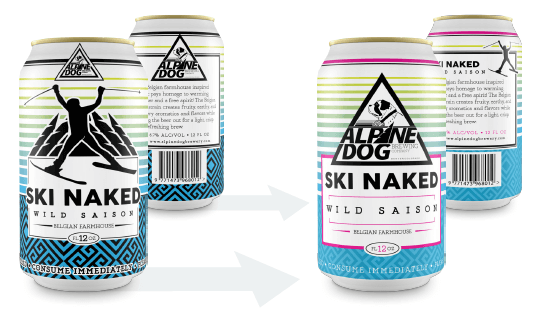Hybrid Market Research Examples
After learning about what hybrid market research is, and how to design a hybrid study, we thought it’d be helpful to show some real-world examples of it in action. The two use cases below go into more detail into the practical application of a hybrid market research approach.
Qualitative + Quantitative
Background
Alpine Dog Brewing Co., a brewery based out of Denver, Colorado, strives to bring bold and unique brews to a bold and unique population. Part of this boldness is communicated through the beer labels on the bottles and cans. Alpine Dog was in the early stages of developing new labels for the upcoming release of their featured beer and wanted to leverage the voice of the consumer through market research for the first time in order to determine which label to move forward with into development.
How Hybrid Research Was Used
In an initial quantitative phase utilizing our Concept Prioritizer™, Alpine Dog Brewing was able to evaluate 6 different concepts and determine which one should be used moving forward. However, based on the assessment in this quantitative phase, we found running a qualitative refinement immediately after would help them understand how to improve the concept.

The Results
Alpine was able to use the results from both phases of research to make improvements to the winning design, creating a strong label to move into production. Additionally, the fact that the research was conducted iteratively, using a hybrid approach, allowed them to use their new label design in early discussions with distributors and better plan for next year’s production. Download the full case study to learn more about the specific findings and how they were applied.
A Three-Phase Approach: Adding Exploratory Research
Background
A leading financial services company was looking to update its loan platform with communication that addresses key pain points identified in the loan process and differentiates them from the competition. They also sought to reinforce the company’s foundational values and hard-fought competitive advantages.
How Hybrid Research Was Used
We implemented a three-phase research approach this time, including quantitative and qualitative methodologies. This approach leveraged the ability to simultaneously conduct a qualitative discussion that uncovered the nuances and thought processes of consumers’ reactions of the messaging while conducting a quantitative prioritization that definitively identified the winning positioning for further development. The winning positioning was then optimized to create a final insight-based and consumer-facing message.
The Results
All phases (quantitative prioritization, qualitative refinement, and qualitative optimization) were conducted in just three weeks. This meant the financial services team had more time to consider and incorporate the key findings and implications from each phase of the project without having to go back to execute additional research. This ensured the resulting claims and messaging were a good fit for their target audience.
As you can see, hybrid research can apply to a variety of use cases and needs. To continue reading more about this specific example, download the full case study below.
Learn how GutCheck’s Persona Connector solution leverages a combination of survey and big data to bring actionability to persona development.
Follow us on
Check Out Our Most Recent Blog Posts
When Vocation and Avocation Collide
At GutCheck, we have four brand pillars upon which we build our business. One of those is to 'lead...
Reflections on Season 1 of Gutsiest Brands
Understanding people is at the heart of market research. Sure, companies want to know what ideas...
Permission to Evolve with Miguel Garcia Castillo
(highlights from Episode #22 of the Gutsiest Brands podcast) Check out the latest lessons from our...
1-877-990-8111
[email protected]
© 2023 GutCheck is a registered trademark of Brainyak, Inc. All rights reserved.
© 2020 GutCheck is a registered trademark of Brainyak, Inc. All rights reserved.



